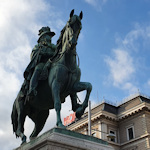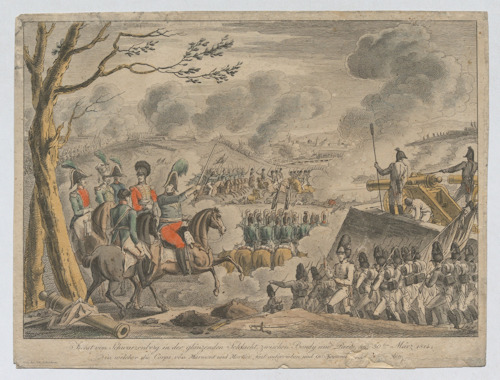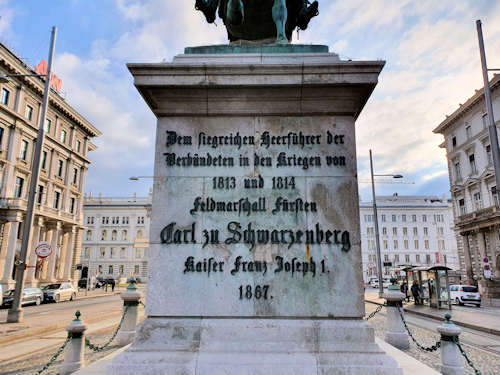
Handing Napoleon one of his very few military defeats earns you a place in military history and, in the case of Karl Philipp Prince of Schwarzenberg, a large monument in Vienna.
- Bronze equestrian statue unveiled in 1867
- Designed by the sculptor Ernst Hähnel
- Located, inevitably, on Schwarzenbergplatz
- Book a themed guided tour* of Vienna
- See also:
Napoleon’s nemesis

(The building behind the monument actually dates from the late 20th century, though the façade fits the historical ambience)
Leave the old town via Schwarzenbergstraße and you pass Café Schwarzenberg before reaching Schwarzenbergplatz square and Palais Schwarzenberg.
You might sense a theme developing here.
The Schwarzenbergs are an old aristocratic family, but the name’s proliferation in this part of Vienna owes much to the exploits of one Karl Philipp (1771 – 1820).
This Vienna-born Schwarzenberg prince enjoyed a distinguished career as a soldier and diplomat in the service of Austria. His crowning achievement was to co-lead the coalition army that defeated Napoleon at the Battle of Leipzig in 1813 and subsequently marched all the way into Paris.

(The prince as portrayed by the artist Jakob Merzin in an engraving published around 1815; Wien Museum Inv.-Nr. W 5962; excerpt reproduced with permission under the terms of the CC0 licence)
Karl Philipp’s decisive role in ending Napoleon’s hegemony won him a large number of admirers throughout Europe, and he remained a figure of renown long after his death.
Vienna likes to acknowledge its famous sons and daughters in street names, and the huge redevelopment works of the late 1800s offered plenty of opportunities to remember Schwarzenberg’s achievements.
The city also pays tribute to the more favoured among its personalities in stone, marble, and bronze. So a Schwarzenberg monument proved an inevitability, too.
Originally requested by Emperor Franz I/II after the prince’s death, the project only came to fruition under the aegis of Emperor Franz Joseph in 1867.

(Schwarzenberg pictured in battle during the Paris campaign, March 30th, 1814; etched by Johann Schönberg; Wien Museum Inv.-Nr. 50651; reproduced with permission under the terms of the CC0 licence)
The equestrian statue of the prince in his field marshal’s uniform emerged from the creative hands of the German sculptor, Ernst Hähnel (1811 – 1891); his smaller bronze model is part of the collection of Vienna’s Heeresgeschichtliches Museum.
The design is relatively straightforward with the granite plinth avoiding much in the way of decorative reliefs. A simple inscription notes (my translation of the German):
To the victorious military leader of the coalition forces in the wars of 1813 and 1814
Field Marshal Prince Carl of Schwarzenberg
Emperor Franz Joseph I
1867
Archduke Albrecht laid the foundation stone for the Schwarzenberg monument on the 50th anniversary (in 1863) of the Battle of Leipzig, and the unveiling took place just over four years later on October 20th.

(The plinth honours Schwarzenberg’s exploits in the Napoleonic wars)
Franz Joseph attended that day, along with numerous members of the Imperial and Schwarzenberg family, the higher echelons of the military, politicians, diplomats, soldiers, and similar (and numerous veterans of the Leipzig hostilities).
The monument sits alongside the great Ringstrassen boulevard at the northern edge of Schwarzenbergplatz. The other end of the square has the giant Red Army monument and the Hochstrahlbrunnen fountain.
The surrounding area is actually riddled with sightseeing opportunities.
Follow the direction the horse is trotting toward, for example, and walk into the old town to pass Flanagan’s pub (great for watching football) and the Haus der Musik.
But if you prefer to stay on topic, travel along the ring anti-clockwise to eventually find the monument to one of Schwarzenberg’s military comrades: Field Marshal Radetzky.
How to get to Schwarzenberg
Various Ring trams (2, D, or 71) and one of the old town buses (2A) stop within shouting distance of the monument. I won’t tell you the name of the stop, but it begins with Schwarzenberg and ends with Platz.
Address: Schwarzenbergplatz, 1010 Vienna